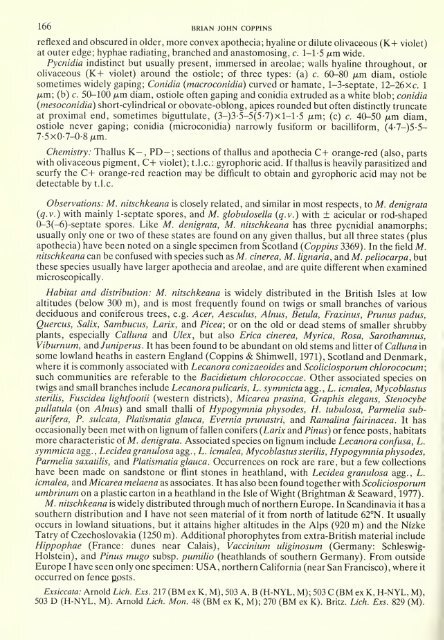Bulletin of the British Museum (Natural History)
Bulletin of the British Museum (Natural History)
Bulletin of the British Museum (Natural History)
Create successful ePaper yourself
Turn your PDF publications into a flip-book with our unique Google optimized e-Paper software.
166 BRIAN JOHN COPPINS<br />
reflexed and obscured in older, more convex apo<strong>the</strong>cia; hyaline or dilute olivaceous (K+ violet)<br />
at outer edge; hyphae radiating, branched and anastomosing, c. 1-1-5 /jlui wide.<br />
Pycnidia indistinct but usually present, immersed in areolae; walls hyaline throughout, or<br />
olivaceous (K+ violet) around <strong>the</strong> ostiole; <strong>of</strong> three types: (a) c. 60-80 /xm diam, ostiole<br />
sometimes widely gaping; Conidia {macroconidia) curved or hamate, 1-3-septate, 12-26 xc. 1<br />
/Lim; (b) c. 50-100 (xm diam, ostiole <strong>of</strong>ten gaping and conidia extruded as a white blob; conidia<br />
(mesoconidia) short-cylindrical or obovate-oblong, apices rounded but <strong>of</strong>ten distinctly truncate<br />
at proximal end, sometimes biguttulate, (3-)3-5-5(5-7)xl-l-5 /xm; (c) c. 40-50 /xm diam,<br />
ostiole never gaping; conidia (microconidia) narrowly fusiform or bacilliform, (4-7-)5-5-<br />
7-5x0-7-0-8/>tm.<br />
Chemistry: Thallus K-, PD-; sections <strong>of</strong> thallus and apo<strong>the</strong>cia C+ orange-red (also, parts<br />
with olivaceous pigment, C+ violet); t.l.c: gyrophoric acid. If thallus is heavily parasitized and<br />
scurfy <strong>the</strong> C+ orange-red reaction may be difficult to obtain and gyrophoric acid may not be<br />
detectable by t.l.c.<br />
Observations: M. nitschkeana is closely related, and similar in most respects, to M. denigrata<br />
{q.v.) with mainly 1-septate spores, and M. globulosella (q.v.) with ± acicular or rod-shaped<br />
0-3 (-6) -septate spores. Like M. denigrata, M. nitschkeana has three pycnidial anamorphs;<br />
usually only one or two <strong>of</strong> <strong>the</strong>se states are found on any given thallus, but all three states (plus<br />
apo<strong>the</strong>cia) have been noted on a single specimen from Scotland {Coppins 3369). In <strong>the</strong> field M.<br />
nitschkeana can be confused with species such as M. cinerea, M. lignaria, and M. peliocarpa, but<br />
<strong>the</strong>se species usually have larger apo<strong>the</strong>cia and areolae, and are quite different when examined<br />
microscopically.<br />
Habitat and distribution: M. nitschkeana is widely distributed in <strong>the</strong> <strong>British</strong> Isles at low<br />
altitudes (below 300 m), and is most frequently found on twigs or small branches <strong>of</strong> various<br />
deciduous and coniferous trees, e.g. Acer, Aesculus, Alnus, Betula, Fraxinus, Prunus padus,<br />
Quercus, Salix, Sambucus, Larix, and Picea; or on <strong>the</strong> old or dead stems <strong>of</strong> smaller shrubby<br />
plants, especially Calluna and Ulex, but also Erica cinerea, Myrica, Rosa, Sarothamnus,<br />
Viburnum, and Juniperus. It has been found to be abundant on old stems and Utter <strong>of</strong> Calluna in<br />
some lowland heaths in eastern England (Coppins & Shimwell, 1971), Scotland and Denmark,<br />
where it is commonly associated with Lecanora conizaeoides and Scoliciosporum chlorococum;<br />
such communities are referable to <strong>the</strong> Bacidietum chlorococcae . O<strong>the</strong>r associated species on<br />
twigs and small branches include Lecanora pulicaris, L. symmicta agg., L. icmalea, Mycoblastus<br />
sterilis, Fuscidea lightfootii (western districts), Micarea prasina, Graphis elegans, Stenocybe<br />
pullatula (on Alnus) and small thalli <strong>of</strong> Hypogymnia physodes, H. tubulosa, Parmelia subaurifera,<br />
P. sulcata, Platismatia glauca, Evernia prunastri, and Ramalina fairinacea. It has<br />
occasionally been met with on lignum <strong>of</strong> fallen conifers (Larix and Pinus) or fence posts, habitats<br />
more characteristic <strong>of</strong> M. denigrata. Associated species on lignum include Lecanora confusa, L.<br />
symmicta agg. , Lecidea granulosa agg., L. icmalea, Mycoblastus sterilis, Hypogymnia physodes,<br />
Parmelia saxatilis, and Platismatia glauca. Occurrences on rock are rare, but a few collections<br />
have been made on sandstone or flint stones in heathland, with Lecidea granulosa agg., L.<br />
icmalea, and Micarea melaena as associates. It has also been found toge<strong>the</strong>r with Scoliciosporum<br />
umbrinum on a plastic carton in a heathland in <strong>the</strong> Isle <strong>of</strong> Wight (Brightman & Seaward, 1977).<br />
M. nitschkeana is widely distributed through much <strong>of</strong> nor<strong>the</strong>rn Europe. In Scandinavia it has a<br />
sou<strong>the</strong>rn distribution and I have not seen material <strong>of</strong> it from north <strong>of</strong> latitude 62°N. It usually<br />
occurs in lowland situations, but it attains higher altitudes in <strong>the</strong> Alps (920 m) and <strong>the</strong> Nizke<br />
Tatry <strong>of</strong> Czechoslovakia (1250 m). Additional phorophytes from extra-<strong>British</strong> material include<br />
Hippophae (France: dunes near Calais), Vaccinium uliginosum (Germany: Schleswig-<br />
Holstein), and Pinus mugo subsp. pumilio (heathlands <strong>of</strong> sou<strong>the</strong>rn Germany). From outside<br />
Europe I have seen only one specimen: USA, nor<strong>the</strong>rn California (near San Francisco), where it<br />
occurred on fence ppsts.<br />
Exsiccata: Arnold Lick. Exs. Ill (BM ex K, M), 503 A, B (H-NYL, M); 503 C (BM ex K, H-NYL, M),<br />
503 D (H-NYL, M). Arnold Lick. Mon. 48 (BM ex K, M); 270 (BM ex K). Britz. Lick. Exs. 829 (M).

















